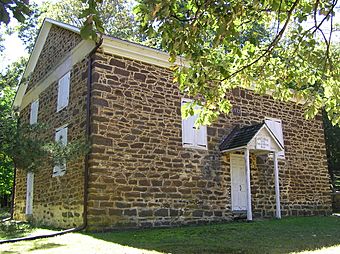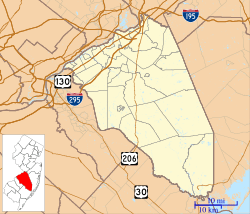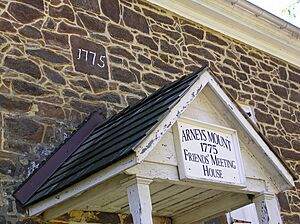Arney's Mount Friends Meetinghouse and Burial Ground facts for kids
|
Arney's Mount Friends Meeting House and Burial Ground
|
|

Arney's Mount Friends Meeting House
|
|
| Location | Arney's Mount, NJ (Springfield Township) |
|---|---|
| Built | 1775 |
| Architect | Samuel Smith |
| Architectural style | Vernacular |
| NRHP reference No. | 73001083 |
Quick facts for kids Significant dates |
|
| Designated | January 18, 1973 |
The Arney's Mount Friends Meeting House and Burial Ground is a historic building in Arney's Mount, Burlington County, New Jersey. It is a special place where Quakers, also known as Friends, have gathered for worship for a very long time. It also has a burial ground where many people from the community are laid to rest. You can find it where Mount Holly-Juliustown and Pemberton-Arney's Mount Roads meet.
Contents
A Look Back: History of the Meeting House
In 1743, a group of Quakers living near Shreve's Mount (now called Arney's Mount) wanted a place to worship. They asked the Burlington Monthly Meeting for permission to hold their Sunday services.
A few years later, a meeting house was built. The builder was Samuel Smith, and his name is carved on a stone above the front door. The meeting house was completed in 1775.
Over time, the area changed, and fewer people attended the Arney's Mount Meeting. The Preparative Meeting, which started in 1776, stopped meeting in 1871. However, the meeting house was still used sometimes for worship and Sunday school. Since 1941, worship services have usually been held twice a month.
Building Features: Architecture of the Meeting House
This building is a unique example of early stone construction for a Quaker meeting house. It was built using local bog iron stone, which was dug right from the mount it stands on. Most meeting houses in South Jersey are made of brick, making this one special.
Inside, the pillars that hold up the upper gallery are made from solid wood. The benches are held together with bolts made by hand. The wood inside has kept its natural, aged color, and no paint has ever been used on the interior walls.
The windows are placed in an unusual way to let in as much light as possible. There's an upper gallery on three sides that can be opened or closed using hand-carved wooden panels. The building has never had electricity, a formal heating system, or indoor plumbing. The original cedar roof has been replaced with asphalt shingles. A chunk stove now warms the house for winter meetings, replacing an older "pot-bellied" stove that was stolen. You can still see the iron rings on the south wall where horses used to be tied up.
Who Built It?
Local stories say that Samuel Smith was the builder. His name, "S. Smith," is carved into a stone on the meeting house. It was common for builders to carve their initials on buildings in those days. Quakers usually didn't do this because they believed in working together and avoiding showing off. However, members of the Smith family were important to the Arney's Mount meeting.
Another name, "I. Coate," is carved on the opposite side of the meeting house. This suggests that Samuel Smith might not have been the only person involved in building it. Perhaps one person handled the money, while the other was the main builder.
Fires and Rebuilding
The meeting house was damaged by fire twice. According to old stories, the first fire happened on February 17, 1800. It destroyed the roof and much of the wood inside. People supposedly saved the floor by throwing snow through the doors and windows. Records show a payment in 1801 for "service done at the time the Mount Meeting House was Burnt."
The second fire, in 1809, almost completely destroyed the building, leaving only its stone walls. You can still see charred wood from the fire under the stairs in the corners of the meeting house. After this fire, parts of the building were rebuilt, and it looked much like it does today by 1811. The building was empty from 1871 until the meeting started again in 1941.
Resting Place: The Burial Grounds
The burial grounds are still used today and are even older than the meeting house itself. Records show that people lived in this area before the Quakers asked to build the meeting house in 1743.
A stone wall, built in 1860, surrounds part of the graveyard. However, many people were buried "outside the wall." This might have been because they were no longer in good standing with the Meeting, or they were buried in unmarked spots before the walls were built.
Quakers traditionally did not mark graves in the earliest times. Instead, records were kept by rows. Later, markers were used, and some of these markers have dates from before the Meeting was officially established. In 1870, a wall made of local sandstone was built around the graveyard.
Many names of early settlers are found in the graveyard, such as "Lamb," "Lappencott," "Shreve," "Gaskill," and "Newbold." These families were very important to the history of Mount Holly and Pemberton, New Jersey. The burial ground is still accepting requests for new burials today.
Notable Burials
- Barclay White: An author, cranberry farmer, historian, and politician.
- Alfred Lacey Hough: A colonel and brigadier general during the American Civil War.
See Also
- List of the oldest buildings in New Jersey




